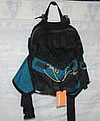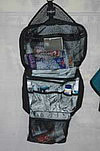My recent trip to Europe was my “teeth cutting” “break in” maiden voyage and as you know before the trip I was in terrible anxiety. What kind of luggage should I have? How do I handle money? How should I book a flight and on what airline? How can I survive without knowing the local languages? “How do the trains work in Europe? I had so many concerns. And I remember the feeling only too well of stepping outside of the Metro in Paris. My moment of truth had arrived. But I did it and I survived. Now my bags are already packed and I could take another trip tomorrow with hardly any worries. Before that first trip I spent a lot of time learning how to travel. I talked to a lot of people and even watched some “how to travel” videos. I then went out and purchased what I thought I would need and then “field tested” everything in the streets of Paris and Rome. Here are some of my conclusions.
1. Traveling is exciting and fun, but it is a lot more enjoyable if you know your location in advance. Preparation is key. Don’t try to see everything the first time. Focus on just a few places and prepare as much as possible. I recall walking through the Louvre and not having a clue what I was looking at. I just knew that it was the right place to be. I made a mental note to return, but not before I have taken a little time to study some part of the collection. I am going to study impressionism and then return to see the originals. Many places like the Louvre and the Vatican have personal audio headset tours that you can purchase and take a walking tour. Such things take a lot of time, but they are worth it. Give your self time and focus on quality instead of quantity. My first trip was about quantity.
 You will notice the large yellow strap in the main luggage piece. I added that as a safety feature in case my luggage was mishandled and also as easy identification. I included combination locks set to the same numbers on all sippers. I also matched the color of the locks to the color of the belt. I wanted to make my luggage stand out as much as possible so that other people would be less likely to misidentify it as their luggage and in case my luggage was lost it would be easy to describe. The locks were added so that it would be less easy to “plant” articles in my luggage. These were all safety measure suggested to me by more than one travel expert. I agree. Keep locks on everything and make identification obvious.
You will notice the large yellow strap in the main luggage piece. I added that as a safety feature in case my luggage was mishandled and also as easy identification. I included combination locks set to the same numbers on all sippers. I also matched the color of the locks to the color of the belt. I wanted to make my luggage stand out as much as possible so that other people would be less likely to misidentify it as their luggage and in case my luggage was lost it would be easy to describe. The locks were added so that it would be less easy to “plant” articles in my luggage. These were all safety measure suggested to me by more than one travel expert. I agree. Keep locks on everything and make identification obvious. I also included a small shoulder/waist day bag. I used this bag every time I traveled from my hotel on day trips. It mostly carried my camera equipment. I purposely did not use a camera bag because I did not want to make it obvious that I has carrying a lot of expensive camera equipment. Most importantly this bag could be used either as a shoulder bag or a hip pack. I ended up using the bag as a hip bag most of the time. I also carried a small umbrella in this pack. Indispensable. You will notice the large colorful identification tag. I used this in airports, but not while I was on the streets. There I wanted to blend in as much as possible.
I also included a small shoulder/waist day bag. I used this bag every time I traveled from my hotel on day trips. It mostly carried my camera equipment. I purposely did not use a camera bag because I did not want to make it obvious that I has carrying a lot of expensive camera equipment. Most importantly this bag could be used either as a shoulder bag or a hip pack. I ended up using the bag as a hip bag most of the time. I also carried a small umbrella in this pack. Indispensable. You will notice the large colorful identification tag. I used this in airports, but not while I was on the streets. There I wanted to blend in as much as possible.
 The next item you see is my toilet kit. The bad thing about this kit is that it large and could carry way too much. The good thing about this system is that is comes apart to allow so you can take just one part in your small carry on bag. There is a hook on this toilet bag so that it can hang in your shower. I could have used something half this size and I will probably buy a smaller system.
The next item you see is my toilet kit. The bad thing about this kit is that it large and could carry way too much. The good thing about this system is that is comes apart to allow so you can take just one part in your small carry on bag. There is a hook on this toilet bag so that it can hang in your shower. I could have used something half this size and I will probably buy a smaller system.
 This is my shirts and pants bag along with a folding board. If you use this set up your shirts and pants travel very compact and perfectly folded. A folding board is something that surprised me. I would never have imagined that I would use such a thing, but I did, and it is a great system. I highly recommend a folding board. The other items are called cubes, separate bags for separate kinds of things, Notice the colors. I recommend the use of color for organization purposes. It also makes your luggage easily describable in case of damage or loss. Nothing in my luggage was lose, everything was in a cube of one size or another. I used one for underwear and socks and the other for camera and computer cables, power adapters and so on. If your bags are inspected custom officers the cubing system makes the process much easier and saves you a lot of trouble. Inspection officers do not bother with the cubes holding clothes.
This is my shirts and pants bag along with a folding board. If you use this set up your shirts and pants travel very compact and perfectly folded. A folding board is something that surprised me. I would never have imagined that I would use such a thing, but I did, and it is a great system. I highly recommend a folding board. The other items are called cubes, separate bags for separate kinds of things, Notice the colors. I recommend the use of color for organization purposes. It also makes your luggage easily describable in case of damage or loss. Nothing in my luggage was lose, everything was in a cube of one size or another. I used one for underwear and socks and the other for camera and computer cables, power adapters and so on. If your bags are inspected custom officers the cubing system makes the process much easier and saves you a lot of trouble. Inspection officers do not bother with the cubes holding clothes.
I also used a check list. I think this is a good idea to use at the beginning of a trip. It might allow you to catch some missed item.
